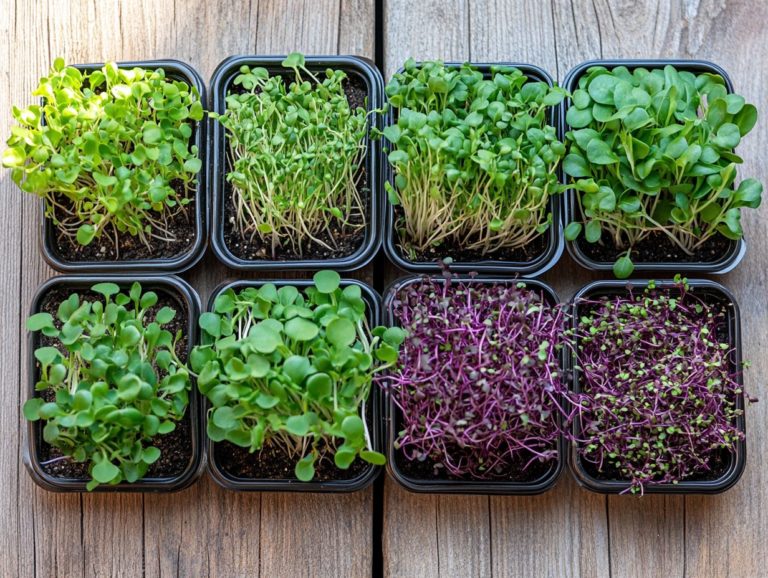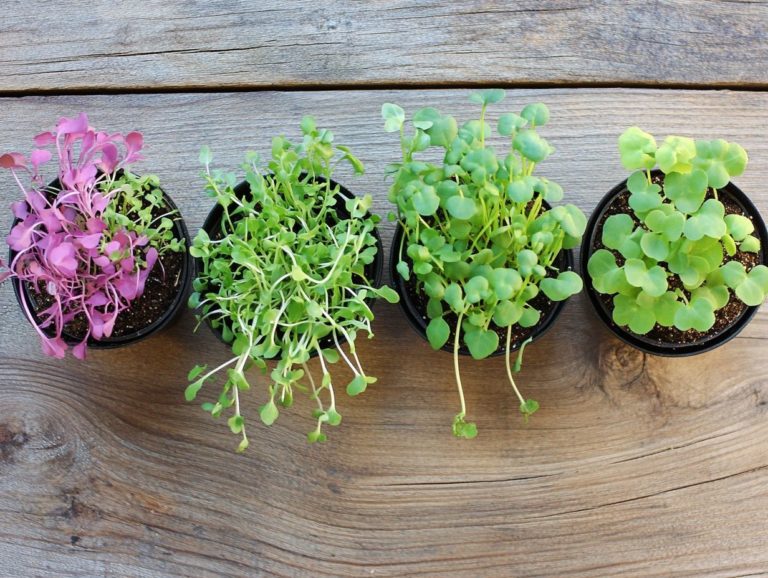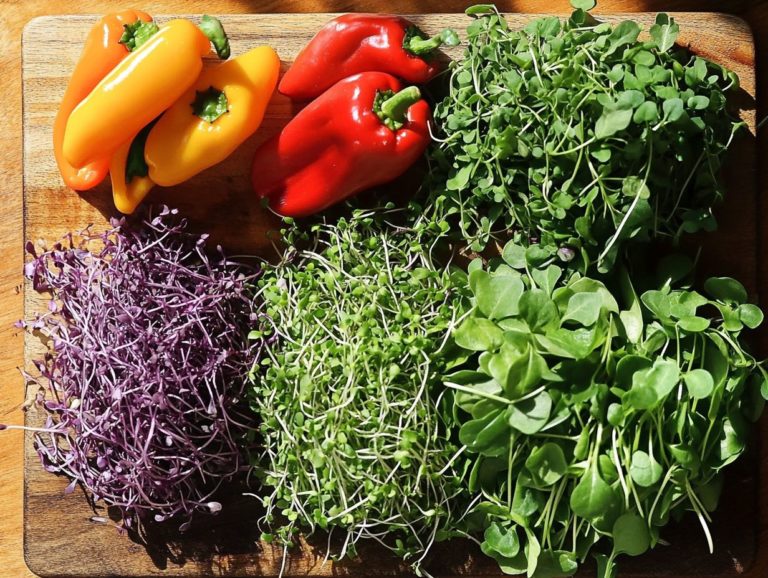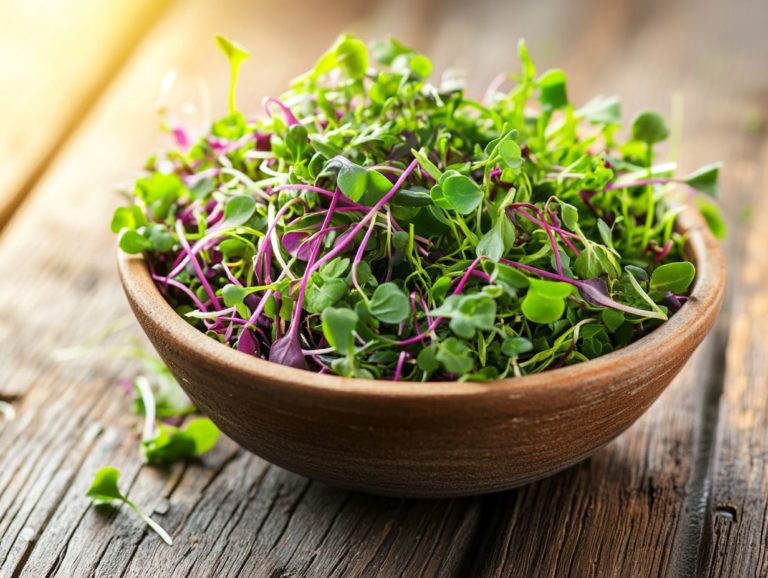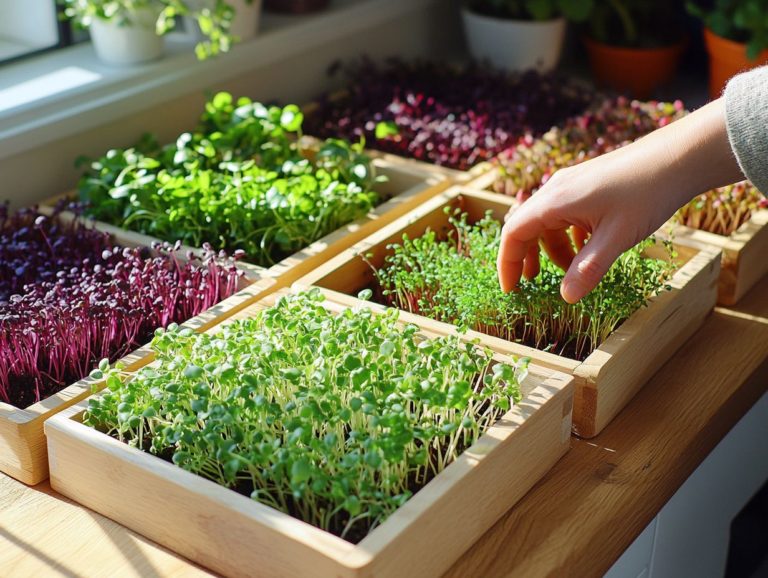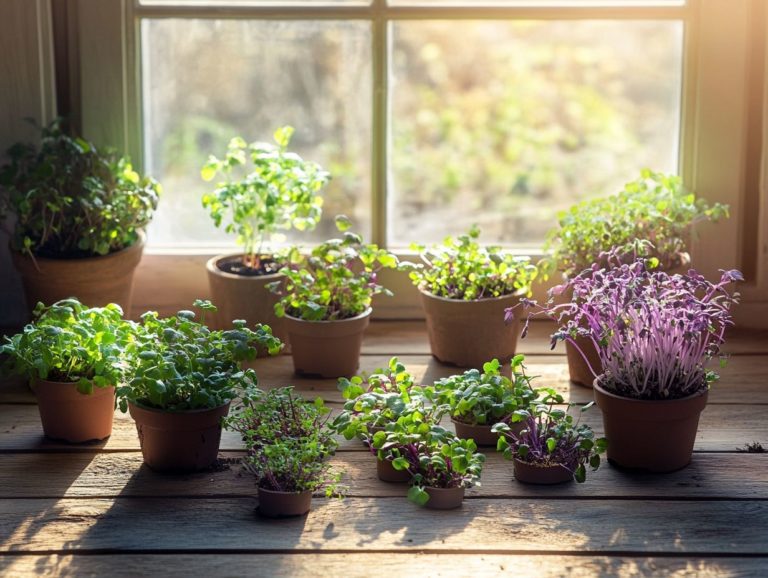The Future of Microgreen Varieties in Cooking
Microgreens are your gateway to vibrant flavors and rich nutrition. These young, edible plants are harvested just after their first true leaves appear, showcasing an array of colors and delicate textures.
Varieties like arugula, basil, and radish pack a punch with concentrated flavors and are brimming with essential nutrients, including vitamins, antioxidants, and phytochemicals.
Their rise in popularity shows a growing demand for nutrient-dense foods, perfectly aligning with the emerging food-as-medicine movement. You can easily cultivate these tiny greens by growing plants without soil, using nutrient-rich water instead or through traditional soil methods, making them accessible to any aspiring gardener.
Beyond their culinary charm, microgreens deliver a remarkable health boost, often containing higher concentrations of vitamins A, C, E, and K compared to their fully grown counterparts. Their petite size enhances their versatility, making them ideal for a wide range of dishes, from fresh salads to elegant garnishes.
For those with limited space, microgreens are a revelation they thrive in compact environments, making sustainable, home-based food production not just possible but enjoyable. This journey toward self-sufficiency enriches your diet and offers a chance to dive deeper into nutrition and sustainable practices.
As more individuals embrace this trend, microgreens play an increasingly vital role in transforming community gardens and nurturing local food systems.
Contents
- The Rise of Microgreens in Cooking
- Key Takeaways:
- Popular Varieties of Microgreens
- How to Incorporate Microgreens into Dishes
- Growing Your Own Microgreens
- Why Microgreens Are the Future of Healthy Eating!
- Frequently Asked Questions
- What are microgreens and how are they different from regular greens?
- What makes microgreens a popular ingredient in cooking?
- Will microgreens continue to be a trend in cooking in the future?
- What are some creative ways to use microgreens in cooking?
- Are there any new microgreen varieties expected to emerge in the future?
- Are there any challenges that may affect the future of microgreen varieties in cooking?
The Rise of Microgreens in Cooking
The emergence of microgreens in cooking has revolutionized how you approach flavor, nutrition, and sustainability in your dishes, mirroring a wider trend toward health and convenience in contemporary gastronomy. These petite greens, brimming with flavor and nutrients, have captured the attention of culinary enthusiasts like yourself, who appreciate their versatility in enhancing both the visual appeal and taste of an array of recipes.
Get ready to transform your cooking with the vibrant flavors of top microgreen varieties for gourmet cooking!
Key Takeaways:
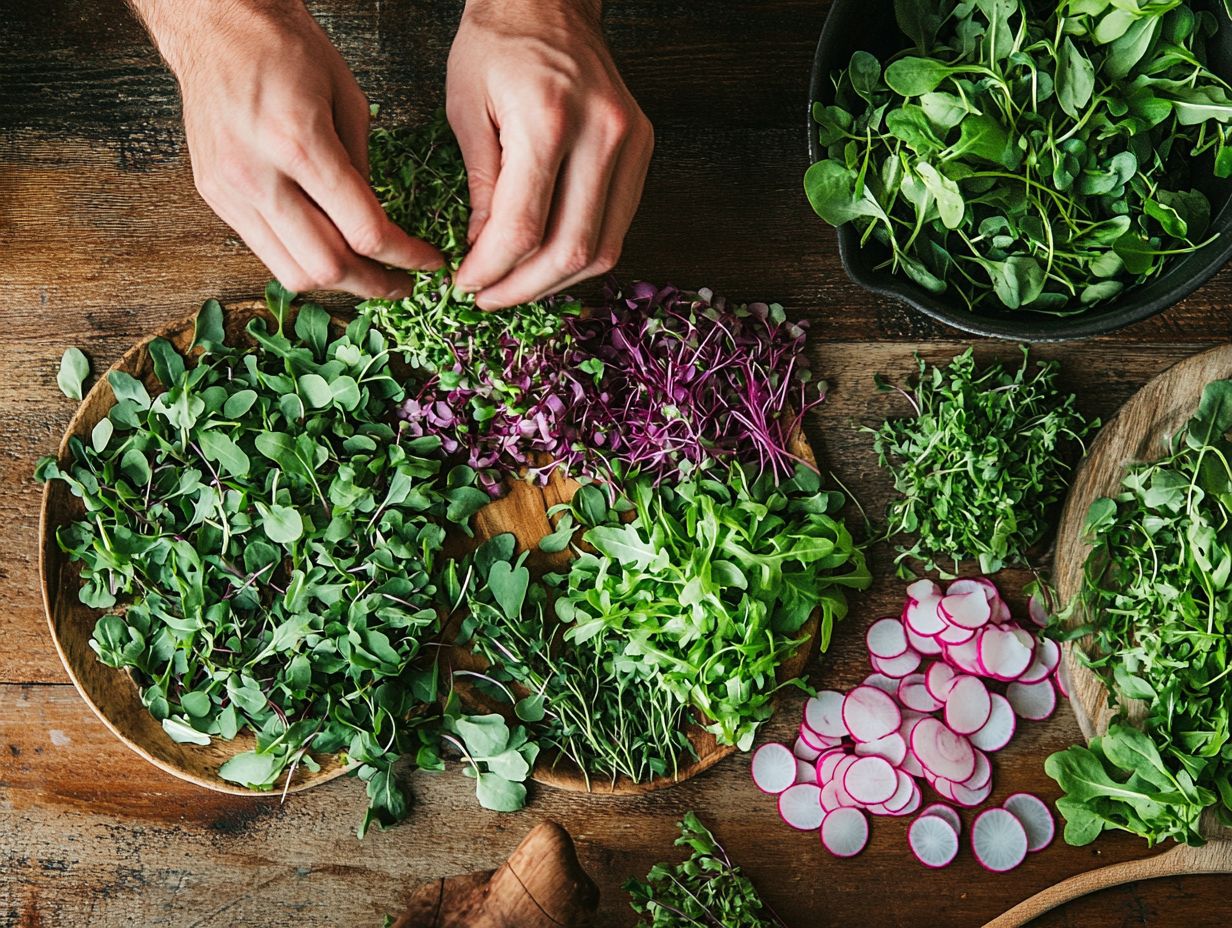
- Microgreens are young, nutrient-packed greens used in cooking for their unique flavors and health benefits.
- With a variety of flavors and textures, microgreens offer endless possibilities for creative dishes.
- The growing trend of microgreens suggests a bright future in cooking, fueled by vertical farming and direct-to-consumer models.
Benefits and Uses in the Culinary World
Microgreens present an impressive array of health benefits and culinary uses. They are a beloved choice in countless dishes. Their concentrated levels of vitamins and antioxidants, combined with vibrant flavors, enhance the nutritional value of your meals and elevate the overall taste, achieving a perfect harmony of health and flavor.
These petite greens, such as arugula, radish, and basil, are not just eye-catching additions to salads; they also serve as delightful garnishes for soups, tacos, and sandwiches. Imagine adding pea shoots to a stir-fry, introducing a hint of sweetness while boosting the protein content. It’s no wonder that professional chefs have embraced them. The role of microgreen varieties in plant-based diets showcases how these greens can transform ordinary plates into stunning presentations, leaving guests enchanted by their fresh bursts of flavor.
Home cooks are also recognizing the charm of these nutrient-dense greens. Incorporating them into smoothies or using them as a topping for avocado toast showcases their versatility and ability to elevate everyday cooking. Each meal becomes a little more extraordinary.
Popular Varieties of Microgreens

You ll find that popular varieties of microgreens, such as arugula, radish, basil, and pea shoots, each offer unique flavor profiles and health benefits. They cater to a wide range of culinary preferences.
These nutrient-dense microgreens do more than enhance the visual appeal of your dishes; they deliver robust flavor and an abundance of essential nutrients. To stay updated, consider exploring microgreen growing trends for 2024, which makes them a favorite among chefs and health-conscious consumers alike.
Types of Microgreens and Their Flavor Profiles
Microgreens present an impressive variety, each boasting unique flavor profiles that can elevate your dishes. For instance, the spicy kick of mustard greens or the subtle nuttiness of sunflower microgreens allows you to explore diverse tastes in your meals.
To enrich this palette, herbs like basil and cilantro impart aromatic notes that transform a simple salad into a delightful gourmet experience. Chefs increasingly see these tiny greens as essential ingredients in sauces, dressings, and even main courses. By skillfully combining different varieties, you can craft delicious flavors that appeal to health-conscious diners seeking both taste and nutrition.
Whether you re adding a burst of freshness to sandwiches or incorporating them into vibrant smoothie bowls, the versatility of microgreens opens up new culinary avenues that enhance any dining experience.
How to Incorporate Microgreens into Dishes
Incorporating microgreens into your dishes elevates both flavor and nutrition. This offers you the opportunity to unleash your culinary creativity.
Craft vibrant salads, delicious sandwiches, or elegant garnishes. You can even blend them into smoothies; the possibilities are endless.
Get ready to explore these versatile nutrient-dense greens that can transform your meals! They invite you to experiment with new culinary horizons.
Creative and Tasty Recipes
Creative and delicious recipes featuring microgreens can elevate the flavors and nutritional value of any meal. Picture vibrant salads adorned with fresh pea shoots or sandwiches stacked high with zesty radish microgreens. These nutrient-dense greens offer limitless possibilities for enriching your everyday cooking.
You can delve into inventive stir-fries that showcase broccoli or mustard greens. They deliver not just a burst of flavor but also a robust dose of antioxidants. Pairing these greens with eggs in an omelet transforms breakfast into a delightful and nourishing experience.
For those eager to experiment, consider blending microgreens into smoothies. This simple addition can introduce a surprising layer of taste while maximizing health benefits. Whether you choose to use them as garnishes or as star ingredients, these tiny greens invite you to redefine your meals and embark on a flavorful, healthful culinary adventure. To explore options, check out the top microgreen varieties for health enthusiasts. Why wait? Start adding microgreens to your meals today and taste the difference!
Growing Your Own Microgreens

Growing your own microgreens can be incredibly rewarding. You get to immerse yourself in urban agriculture while enjoying fresh, nutrient-dense greens right from your home.
Whether you choose traditional soil methods or prefer growing plants in water without soil, cultivating microgreens is an accessible and sustainable opportunity to elevate your diet and gain numerous health benefits. To maximize your success, consider understanding the growth patterns of microgreen varieties.
Methods and Tips for Home Cultivation
There are many methods and tips for cultivating microgreens at home. Selecting the right seeds and soil, and even utilizing hydroponic systems, can help you unlock the full potential of your microgreens, maximizing both yield and flavor.
Incorporating eco-friendly materials like biodegradable trays and organic fertilizers not only promotes sustainability but also enhances your growing environment’s health.
Explore various lighting options. While natural sunlight is fantastic, grow lights can replicate ideal conditions indoors.
It might also help to experiment with different watering techniques. Techniques like misting or bottom watering can help you discover what works best for you. Observing how various microgreens thrive under different conditions will deepen your understanding of their needs. This knowledge will ultimately lead to a more fruitful harvest and a stronger connection to the nutraceuticals emerging in the market.
Why Microgreens Are the Future of Healthy Eating!
Get ready! The future of microgreens is exciting and full of possibilities. Emerging trends and technological advancements are broadening their influence in the global microgreens market.
As consumers increasingly prioritize health benefits, sustainability, and convenience, the demand for nutrient-rich foods like microgreens is set to surge.
This growth is driven by market factors such as urban agriculture and direct-to-consumer models, ensuring easy access to these vibrant, healthful options.
Trends and Potential Developments
Trends in the microgreens industry reveal a remarkable shift toward sustainability and health among consumers. You can expect innovations in growing techniques, like vertical farming and hydroponics, to enhance both accessibility and yield. This perfectly aligns with the rising demand for these nutrient-packed greens.
As the focus on environmentally friendly practices intensifies, technology is likely to play a pivotal role in shaping your future preferences. Imagine advancements in app-based tracking systems and smart sensors that enable growers to monitor conditions precisely. This ensures optimal growth while minimizing resource waste.
This shift toward efficient cultivation resonates with eco-conscious individuals and deepens your understanding of food origins and nutritional benefits.
As educational campaigns gain momentum, the microgreens market is set to evolve rapidly. It will merge sustainable practices with an elevated consumer awareness that you won’t want to miss.
Frequently Asked Questions

What are microgreens and how are they different from regular greens?
Microgreens are young vegetable greens harvested when they’re only a few inches tall. They differ from regular greens because they are picked at a young age, making them more nutrient-dense and flavorful.
What makes microgreens a popular ingredient in cooking?
Microgreens are popular in cooking because they come in various flavors and add a unique touch to dishes. They are also packed with nutrients, making them a healthy addition to meals.
Will microgreens continue to be a trend in cooking in the future?
Yes, microgreens are expected to remain a popular ingredient in cooking. Their versatility and health benefits make them a staple in many cuisines.
What are some creative ways to use microgreens in cooking?
Microgreens are small, young plants that pack a flavorful punch.
You can garnish dishes, toss them into salads, blend them into smoothies, or sprinkle them on pizza for an extra kick.
Are there any new microgreen varieties expected to emerge in the future?
Absolutely! As more people discover microgreens, expect to see exciting new varieties.
These will feature unique flavors, colors, and textures, adding even more flair to your meals.
Are there any challenges that may affect the future of microgreen varieties in cooking?
One challenge could be the availability and cost of seeds.
As demand rises for diverse microgreens, sourcing high-quality seeds at reasonable prices might become tough.

